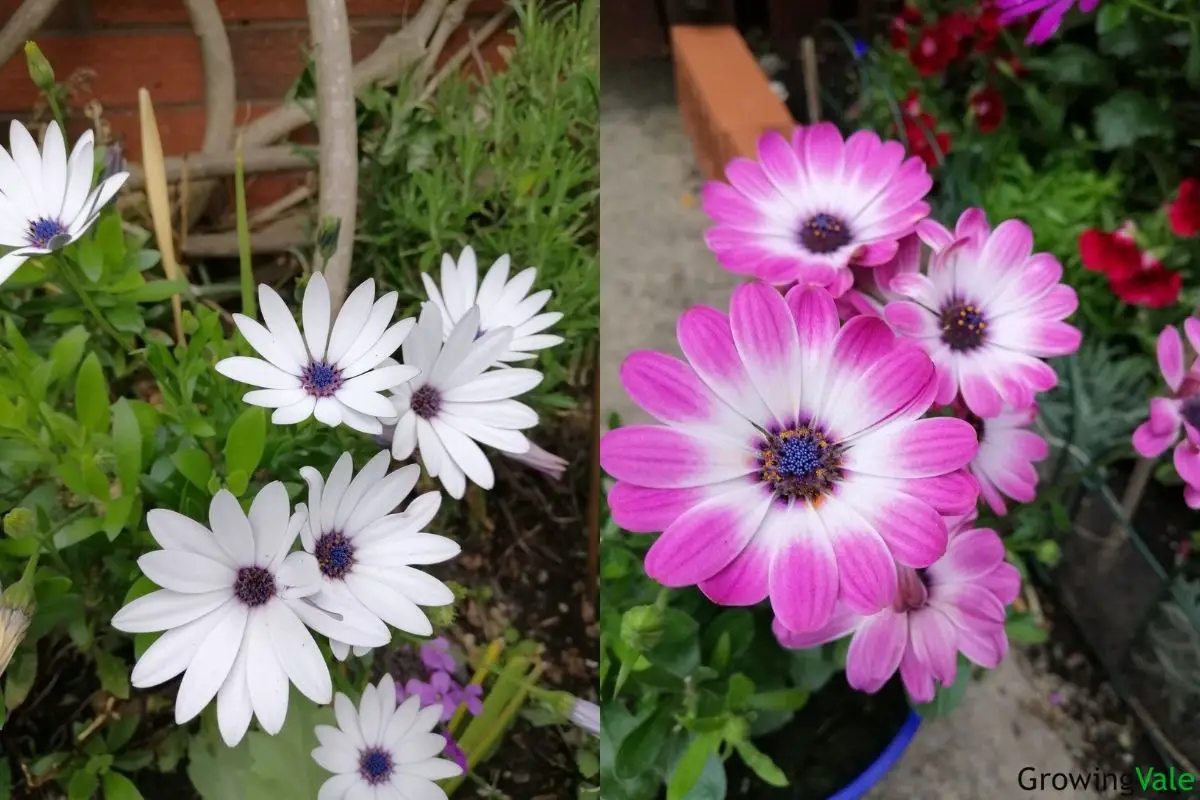African Daisies is the common name given to flowers under the genus Osteospermum. These include around 70 species of daisy-like flowers which originate from South Africa and the Arabian Peninsula. They can be annuals, perennials, or shrubs. The most popular types grown by gardeners today are O. ecklonis, O. jucundum, and their many hybrids and cultivars.
These flowers are extremely popular due to their bold, bright colors and the abundance of blooms. African daisies will bloom profusely from early spring – mid-summer and for this reason, make fantastic additions to any garden. They look absolutely lovely in borders but will grow just as happily in pots, making them great patio plants.
History
First introduced into Europe in the late 1800s, African Daisies have since been bred and cultivated to such a degree that there are just under 950 recognized varieties and cultivars as listed by The Royal Horticultural Society.
Unlike most flowering plants, the genus name for African Daisy shrubs is based on their seeds, not their flowers. Osteo means “bone” while sperma means “seed”, referencing their hard seeds.
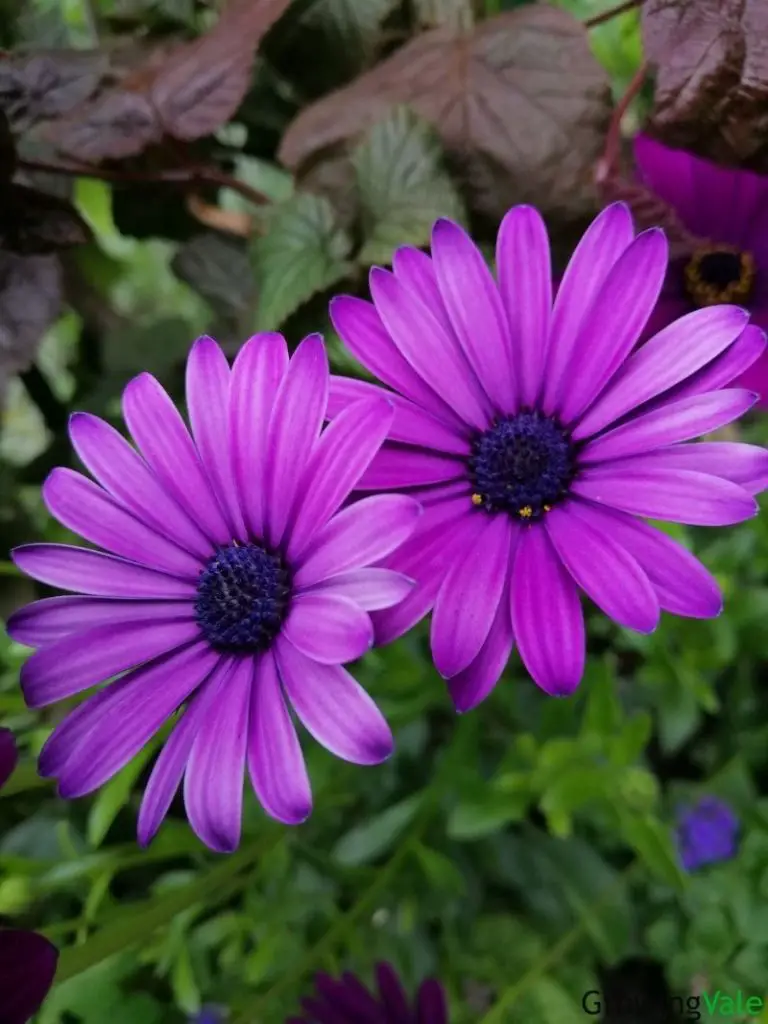
Depending on the type, African Daisies can range from 6-36 inches in height. Foliage is dark green, and flowers come in a range of colors such as pink, purple, white, yellow, and orange. Central discs are usually blue and become yellow when pollen is produced.
Plant Facts
| Scientific name | Osteospermum spp. |
| Common names | African Daisy |
| Genus | Osteospermum |
| Family | Asteraceae |
| Height | 0 ft. 6 in. – 3 ft. 0 in. |
| Width | 0 ft. 9 in. – 2 ft. 0 in. |
| USDA Plant Hardiness Zone | 9a, 9b, 10a, 10b, 11a, 11b |
| Origin | South Africa, Arabian Peninsula |
| Flower colors | Pink, Purple, White, Yellow, Orange, Blue |
| Blooming season | Early spring – mid-summer, late summer – early fall. |
| Plant/Flower special features | Brightly colored flowers |
How to Plant and Grow African Daisies
Plant African Daisies in spring after the risk of frost has passed. Bear in mind that African Daisy plants are perennials that are winter hardy to USDA zones 9-11, in zones below this, they can still grow but will behave as annuals.
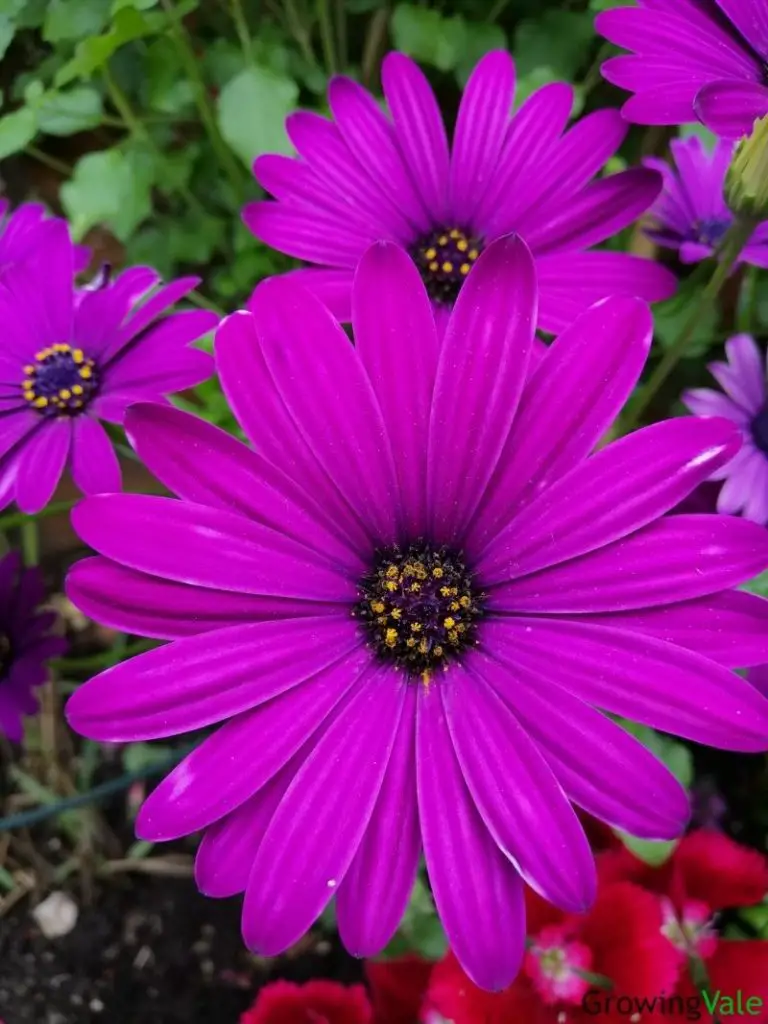
Growing African Daisy Flowers in a Bed
Begin by preparing the garden bed by thoroughly de-weeding. Deeply spade the bed to a depth of 6-10 inches. If needed at this stage, amend clay and sandy soil types.
Dig a hole deep enough to house the roots, then plant the seedlings or rooted cuttings with the top of the roots just below the surface of the soil and water well. Space plants on 1-foot centers to leave enough room for spreading without the risk of overcrowding.
Pinch off any buds or flowers when planting to encourage branching and to produce a stronger plant.
Growing African Daisy Flowers in a Pot
African Daisy plants are extremely well suited to being grown in containers. When planting, ensure you choose a large enough pot to accommodate the final spread of the plant which, depending on the variety, can reach over 14 inches.
Select a well-draining potting mix, and make sure there are enough drainage holes in the container to avoid waterlogged soils. Plant seedlings or rooted cuttings in the same manner as bed planting, ensuring the top of the roots are just below the soil surface.
Lastly, consider any companion plants you may want to include in your container. African Daisy flowers look particularly striking in pots with low-lying petunias, especially if varieties have contrasting colors.
African Daisies are usually grown as annuals in USDA zones below 9 so don’t need to be overwintered. However, in some warmer climates with mild winters, they can be overwintered indoors. Make sure to place the container next to a sunny window. Cut them back before placing plants back outdoors the following spring.
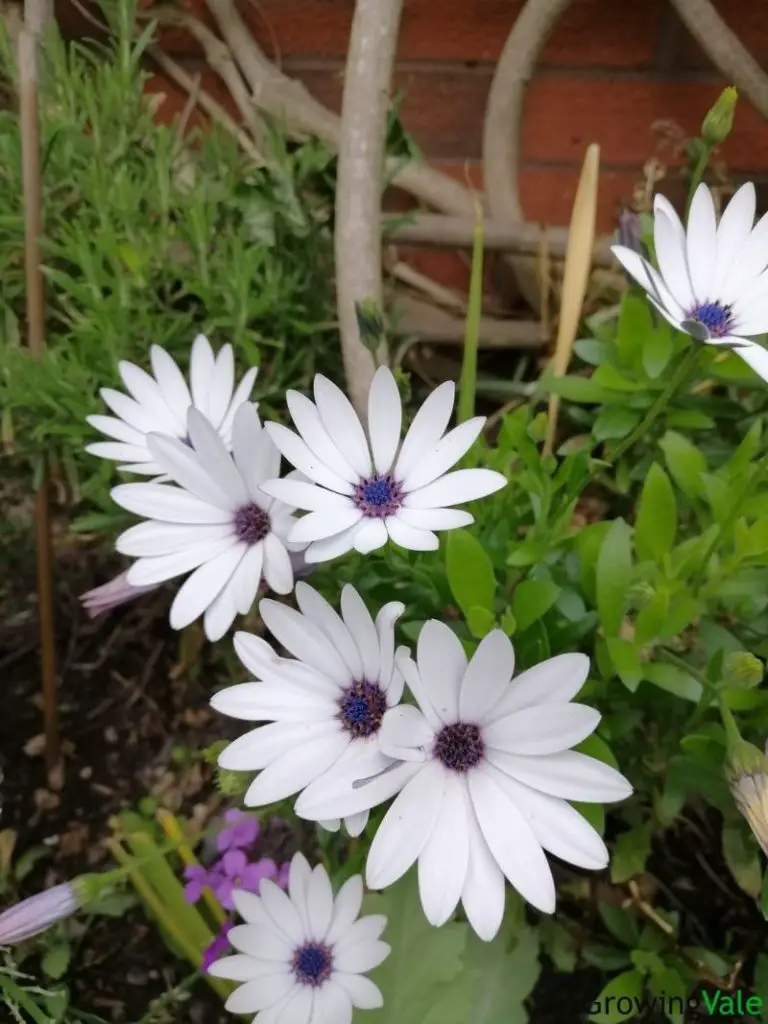
How to Propagate African Daisies
African Daisy plants can be easily propagated through cuttings or from seed. However, since most varieties are hybrids, seeds may not grow true to the parent plant.
Propagation From Cuttings
Begin propagating from cuttings in January to March in time for spring planting. Take a vegetative cutting 4-6 inches long that has at least 2 leaf nodes. Remove any flower buds and lower leaves and dip the end in a low concentration of rooting hormone.
Place African Daisy cuttings in a tray with a sterile starting mix; a soilless medium is recommended. Cover the tray with a plastic cover and place it in a bright spot with indirect sunlight. To maximize success, the soilless medium temperature should be 70-75°F for the first two weeks, then reduced to 60°F once roots have formed.
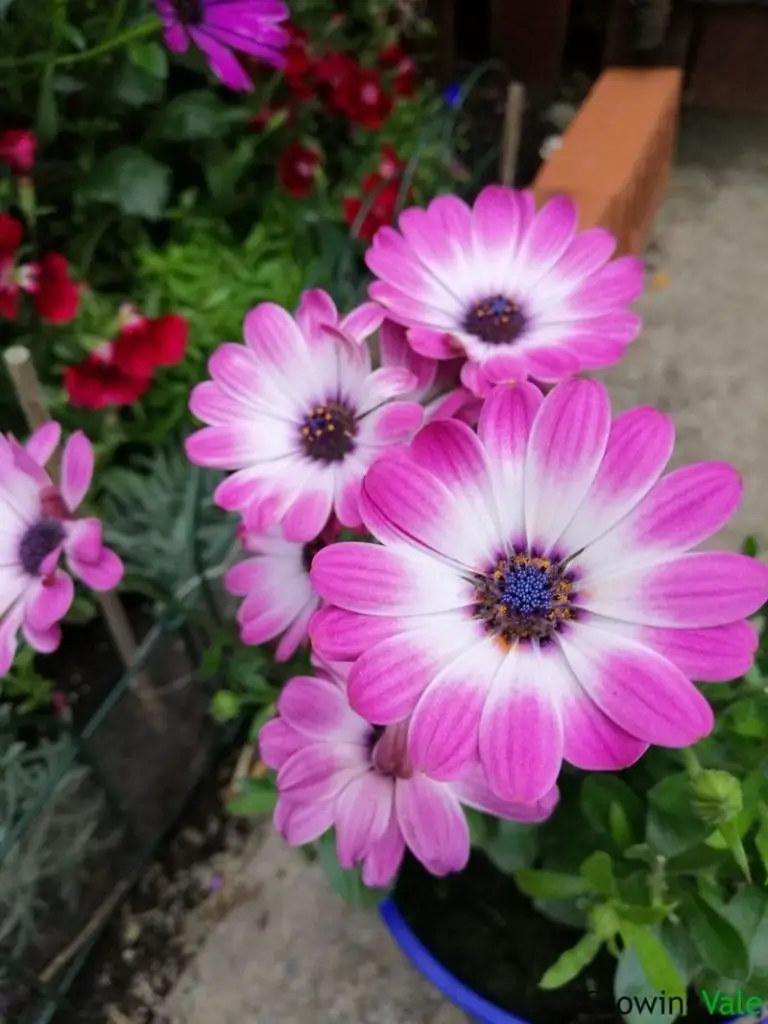
Avoid excessive misting as this can slow down the rooting process by cooling the rooting medium. Within four to six weeks root systems should be developed enough for transplantation outdoors.
Propagation From Seed
To grow African Daisies from seed, begin sowing indoors 6-8 weeks before the last frost. In milder climates, seeds can be directly seeded outdoors in the fall.
Seeds started indoors should be sown in a sterile seed starting mix. Make sure to place trays near a bright light source as insufficient light will result in weak seedlings. The temperature should be 60-65°F and the time to germination is around 14 days.
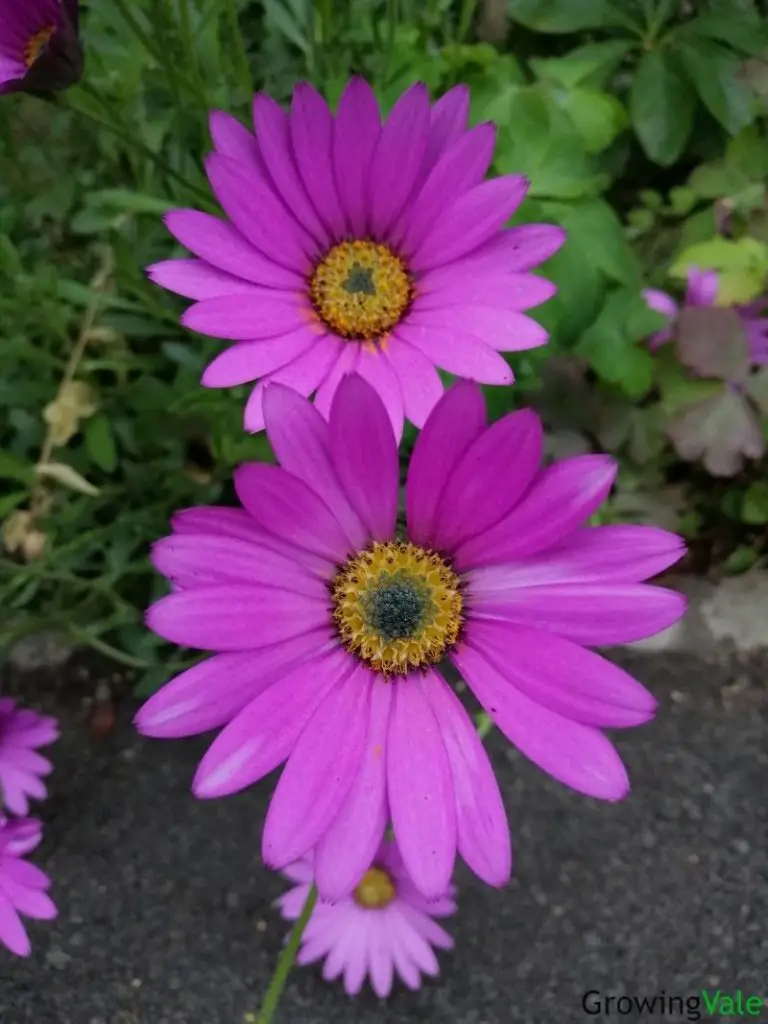
Care and Maintenance
Soil
African Daisies prefer slightly acidic, moist, well-draining soil. Well-draining soil is key for these plants, if needed, amend clay-soil types by adding compost or pine bark to improve drainage and aeration. If the soil type is sandy, improve water retention by amending with 2-3 inches of pine bark humus or peat moss. Otherwise, consider using raised beds with a well-draining compost mix.
Water
African Daisies should be watered regularly and require 1-1.5 inches of water per week, either from rain or irrigation. During hotter periods, make sure to water them more often. Allow the soil to dry out thoroughly between waterings.
Fertilizer
Apply a slow-release fertilizer every 6 weeks to promote growth. Avoid getting fertilizer on emerging foliage as this could cause damage from fertilizer burn.
Mulch beds with 2-3 inches of pine straw or bark to help with water retention and to limit weed growth.
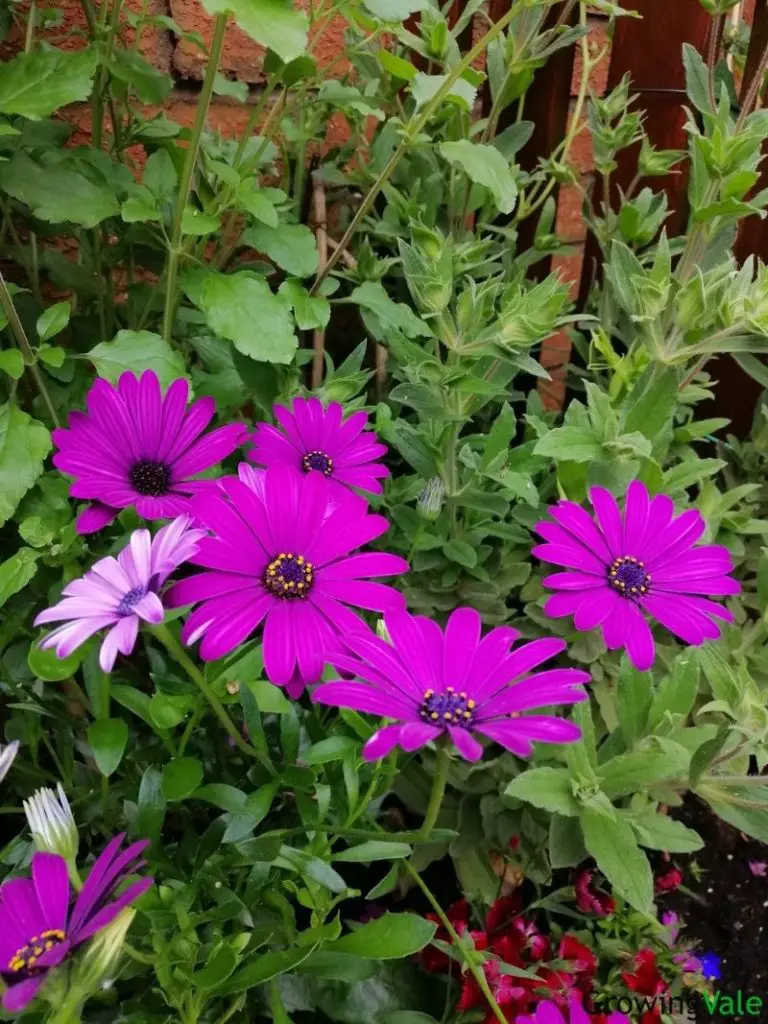
Sunlight
African Daisy bushes should be planted in full sun. They can tolerate partial shade but will produce fewer blooms as a result. These flowers are also phototropic, so will require sunlight for blooms to open to their full potential.
Temperature and Humidity
African Daisies are hardy to USDA zones 9-11. In milder climates, they can be grown as perennials, but most gardeners grow them as annuals.
They need cool night temperatures of below 55°F to flower. Plants in night temperatures higher than this may produce fewer and smaller blooms.
Often flowering will stop in the height of summer, then resume as temperatures begin to cool down closer to fall. To encourage a second flowering, once bloom sizes begin to decrease in size and number, cut back the plant by one-third and apply a dose of water-soluble fertilizer. This should increase new growth in time for a late summer – early fall flowering.
Pest and diseases
African Daisy plants are generally trouble-free, but they are susceptible to powdery mildew and verticillium wilt. If verticillium wilt is spotted, remove infected branches and foliage.
To treat powdery mildew, apply an appropriate fungicide.
These plants can attract thrips and aphids. Routine scouting of plants will help early diagnosis of diseases and pests and help to prevent any serious problems.
Pruning
As soon as flowers begin to fade, deadhead them to prevent the formation of seed pods and to keep the plant as a whole looking attractive.
African Daisies can also be pinched and trimmed regularly to promote fullness, but researching the specific variety is recommended, as some like the “Symphony” series do not require this.
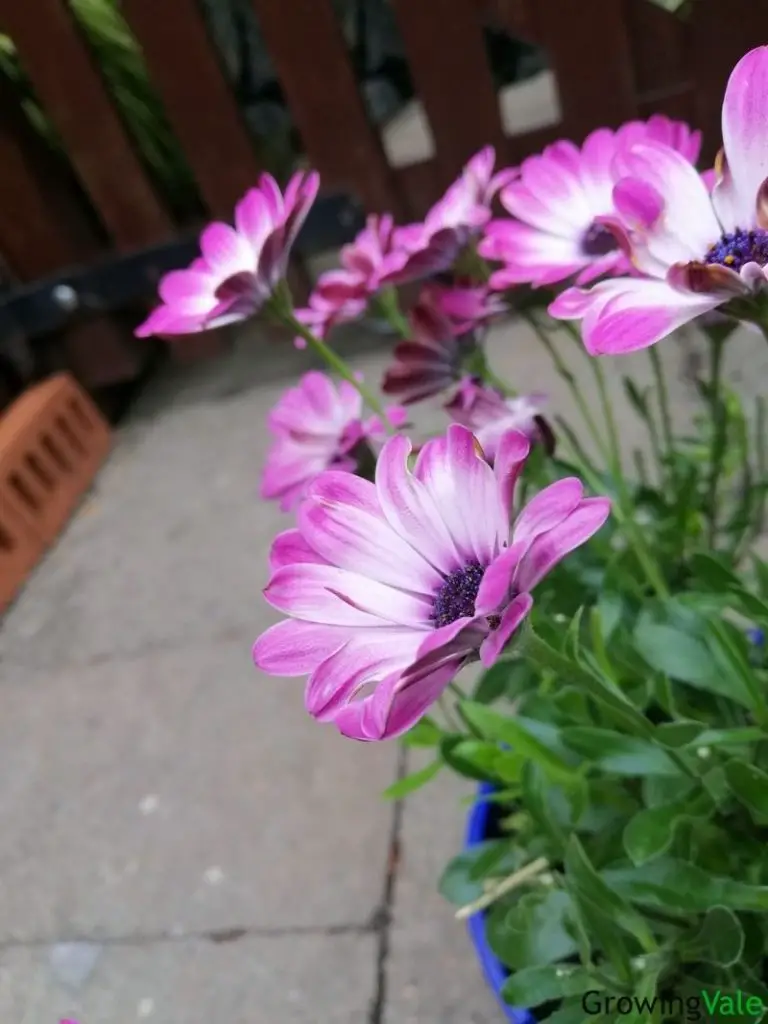
Uses of African Daisies
With their colorful flowers and long blooming season, Osteospermum flowers make particularly lovely cut flowers for the home. They are also a top choice for urban gardens since they grow extremely well in containers. Use them to liven up an apartment balcony or bring a pop of color to patio gardens.
Common Varieties and Cultivars
With so many African Daisy varieties and cultivars, choosing the right fit for your garden may seem daunting. But below is a list of popular and beautiful choices, all with similar care and maintenance needs:
- O. ecklonis “Serenity Blue Eyed Beauty” – Blue Eyed Beauty is part of the Serenity series, and has single to semi-double flowers with a blue floral disc. Petals are a buttery-yellow and fade to white near the base, creating a white ring around the blue-purple central eye.
- O. ecklonis “Zion Purple Sun” – Award-winning Zion Purple Sun (FleuroStar award winner), is a member of the Zion series which takes its inspiration from the colors of Zion National Park, Utah. Flowers are a vivid orange, fading to a dark purple center with a golden-yellow central eye.
- O. fruticosum Shrubby Daisybush – Also known as the Blue-eyed Daisy, this African Daisy bush has pure white petals and a fine dark purple ring around the dark blue floral discs.
- O. jucundum Delightful African Daisy – This flower has light purple-pink petals and a dark purple central eye. Floral discs are blue.
- Osteospermum “Soprano Vanilla Spoon” – One of the more interesting African Daisy plants, Soprano Vanilla Spoon has creamy white petals which are pinched in the middle to create spoon-shaped petals. Floral discs are yellow. This is a member of the Soprano series.
Conclusion
African Daisies are colorful daisy-like flowers that are native to South Africa and the Arabian Peninsula. Part of the genus Osteospermum, they have been cultivated to such a degree that there are just under 950 varieties and cultivars as listed under The Royal Horticultural Society.
They can be annuals, perennials, or shrubs, however, their popularity in Western Europe and North America where temperatures are cooler, lends them to being annuals in these climates. Easily propagated through cuttings or seeds, African Daisy bushes are lovely in sunny borders and make fantastic patio plants since they grow well in pots.
A favorite for cut flowers, and with so many interesting varieties and cultivars, it is of no surprise that African Daisies are a hugely popular choice among gardeners.

